Dear Aspirants, Our IBPS Guide team is providing new series of Reasoning Questions for SBI/IBPS Clerk Prelims so the aspirants can practice it on a daily basis. These questions are framed by our skilled experts after understanding your needs thoroughly. Aspirants can practice these new series questions daily to familiarize with the exact exam pattern and make your preparation effective.
Direction (1-5): Study the following information carefully and answer the questions given below:
Eleven persons A, B, C, D, E, F, G, H, I, J and K are buying some products one after another but not necessarily in the same order.
At most two persons are buying products before F. Only one person is buying between D and F. One person is buying between C and D. C is buying immediately before H. The number of persons buying products after H is the same as the number of persons buying products before I. K is buying immediately before B and immediately after J. Only two persons are buying products between G and J. A is buying the product immediately before E.
1) How many persons are buying their products after the one who buys immediately after H?
A.Three
B.Two
C.More than three
D.One
E.None of these
2) Who among the following is buying immediately before G?
A.E
B.F
C.B
D.D
E.None of these
3) If all the persons are arranged in alphabetical order starting from A, then find how many persons remain at the same position (excluding A) ?
A.One
B.None
C.Two
D.Four
E.More than Four
4) Who among the following is buying exactly between D and B?
A.E
B.B
C.A
D.H
E.None of these
5) How many persons are buying between E and K?
A.Five
B.Seven
C.Three
D.None
E.Two
Direction (6-10): Study the following information carefully and answer the question given below:
A baggage carousel in the airport delivers nine different bags viz. Backpack, Baggage, Duffel, Hand bang, Purse, Rolling bag, Satchel, Sling bag and Suitcase one after another, but not necessarily in the same order.
Not more than two bags were delivered between Satchel and Rolling bag, which was delivered after Satchel. Purse was delivered immediately before Satchel but is not delivered at first. Rolling bag was delivered exactly between Purse and Suitcase. Baggage was delivered immediately after Suitcase whereas Backpack was delivered immediately before Sling bag. Only two bags were delivered between Hand bag and Duffel, which was neither delivered before Purse nor delivered at the last. Hand bag was not delivered after Sling bag.
6) Which of the following bag was delivered three bags before Sling bag?
A.The one which delivered two bags after Baggage
B.Backpack
C.The one which delivered immediately after Satchel
D.Rolling bag
E.None of these
7) How many bags were delivered between Satchel and Baggage?
A.One
B.Two
C.Three
D.More than three
E.None
8) If Purse is related to Duffel and Sling bag is related to Baggage in a certain way, then which of the following bag is related to Rolling bag?
A.Satchel
B.Hand bag
C.Suitcase
D.Sling bag
E.None of these
9) Which of the following statement is/are true with respect to the final arrangement?
A.Only three bags were delivered between Satchel and Backpack
B.Both Hand bag and Purse were delivered consecutively
C.Neither Sling bag nor Baggage was delivered at the last
D.More than one bag was delivered between Sling bag and Suitcase
E.None of these
10) Hand bag was delivered ___ Rolling bag.
A.Three bags after
B.Four bags before
C.Two bags after
D.Four bags after
E.None of these
Try Puzzle Questions For Online Mock Test
Answers :
Directions (1-5) :
At most two persons are buying products before F. Here we get 3 possible cases i.e. Case 1, Case 2 and Case 3. Only one person is buying between D and F.
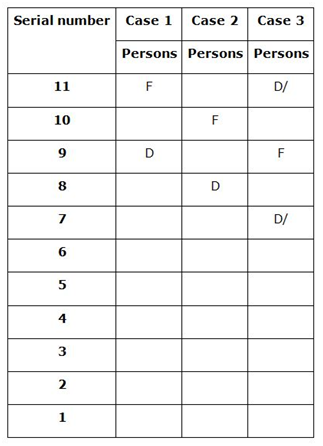
One person is buying between C and D. C is buying immediately before H.
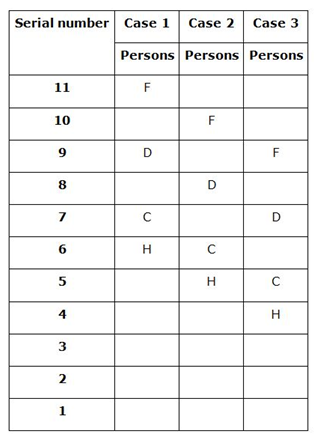
The number of persons buying products after H is the same as the number of persons buying products before I. Case 1 is ruled out now. K is buying immediately before B and immediately after J.
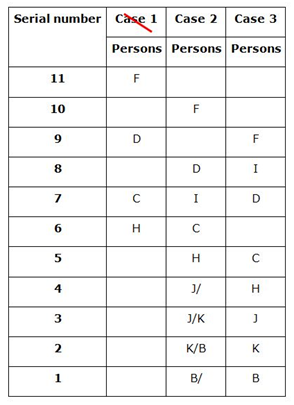
Only two persons are buying products between G and J. Here Case 2 is eliminated.
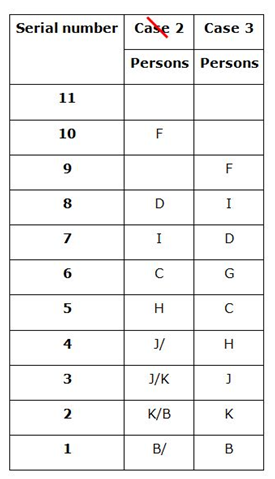
A is buying the product immediately before E. So, the final arrangement is-

1) Answer: B
2) Answer: D
3) Answer: A
4) Answer: D
5) Answer: B
Directions (6-10) :
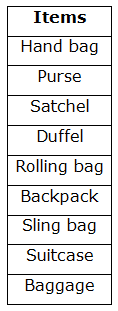
- Not more than two bags were delivered between Satchel and Rolling bag, which was delivered after Satchel.
- Purse was delivered immediately before Satchel but is not delivered at first.
- Rolling bag was delivered exactly between Purse and Suitcase.
Hence, case 3 gets eliminated.
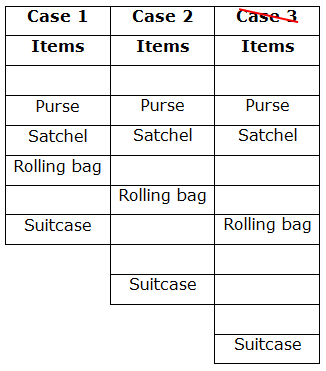
- Baggage was delivered immediately after Suitcase whereas Backpack was delivered immediately before Sling bag.
- Only two bags were delivered between Hand bag and Duffel, which was neither delivered before Purse nor at the last.
- Hand bag was not delivered after Sling bag.
Hence, case 1 and 1a get eliminated.
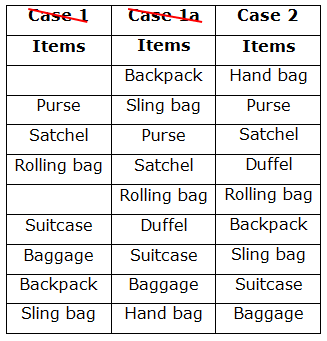
6) Answer: C
7) Answer: D
8) Answer: A
9) Answer: B
10) Answer: B
Direction (11-15): Answer the questions based on the information given below.
Eight persons viz. Jeeva, Kavi, Meera, Nisha, Priya, Reethu, Sofi and Thiru are buying groceries one after another in sequential order. The one who buys first is numbered as 1 and the one who buys immediately after the first person is numbered as 2 and so on but not necessarily in the same order.
Jeeva buys in an odd prime numbered position and immediately before Priya.Only two persons buy between Priya and Sofi who buys immediately after Nisha.Only one person buys between Nisha and Kavi who buys three persons away from Thiru. Neither Thiru nor Reethu buys at first whereas Meera doesn’t buy immediately beforeReethu.
11) Who among the following person buys first?
A.Nisha
B.Sofi
C.Thiru
D.Meera
E.None of these
12) How many people buys between Priya and Reethu?
A.One
B.Two
C.Three
D.More than three
E.None
13) If Jeeva is related to Reethu and Kavi is related to Thiru in a certain way, then who among the following person is related to Priya?
A.Meera
B.Sofi
C.Kavi
D.Reethu
E.None of these
14) Which of the following statement is/are true with respect to the final arrangement?
I)Only two persons buy after Priya.
II)Kavi buys in an odd numbered position.
III) As many persons buy between Meera and Sofi as between Thiru and Jeeva.
A.Only I
B.Only II
C.Both I and III
D.Both I and II
E.Both II and III
15) In which of the following position does Thiru buy?
A.5th
B.3rd
C.6th
D.8th
E.None of these
Direction (16-20): Study the following information carefully and answer the below questions
Nine persons- M, N, O, P, Q, R, S, T, and U are standing in the medical shop one after another with social distance but not necessarily in the same order.
O stands three persons after M. Only one person stands between M and Q. Q stands before M. R stands two persons after O. The number of persons who stand before R is the same as the number of persons who stand after P. S stands two persons before T who stands in odd number position. N stands before U. N does not stand adjacent to M
16) How many persons stand before N?
A.As many persons stand between M and U
B.Four
C.Five
D.As many persons stand after O
E.Six
17) Who among the following person stands immediately after S?
A.P
B.The one who stands two persons before Q
C.The one who stands immediately before T
D.U
E.R
18) If all the persons are arranged in alphabetical order from the one who stands at the first, then how many persons remain in the same position?
A.Two
B.Three
C.One
D.Four
E.None
19) What is the position of O from first?
A.Fifth
B.Fourth
C.Sixth
D.Seventh
E.Eighth
20) How many persons stand between M and U?
A.As many persons stand between Q and T
B.Three
C.One
D.Four
E.As many persons stand between N and O
Try Puzzle Questions For Online Mock Test
Answers :
Directions (11-15) :
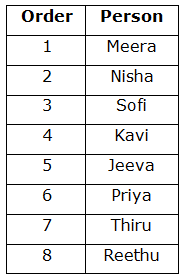
1) Jeeva buys in an odd prime numbered position and immediately before Priya. Only two persons buy between Priya and Sofi who buys immediately after Nisha.
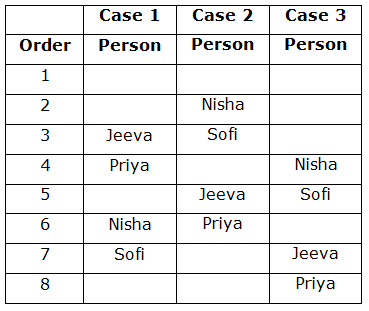
2) Only one person buys between Nisha and Kavi who buys three persons away from Thiru. Neither Thiru nor Reethu buys at first whereas Meera doesn’t buy immediately before Reethu. Hence, cases 1 and 3 get eliminated.
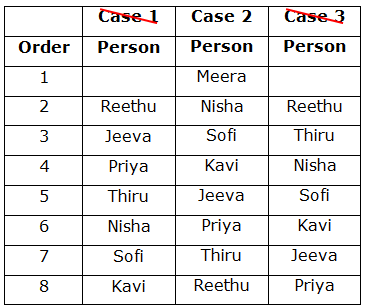
11) Answer: D
12) Answer: A
13) Answer: B
14) Answer: C
15) Answer: E
Directions (16-20) :
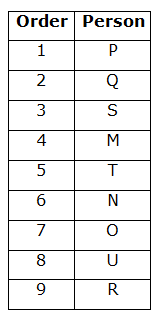
We have,
- O stands three persons after M.
- Only one person stands between M and Q.
- Q stands before M.
- R stands two persons after O.
From the above condition, there are two possibilities.
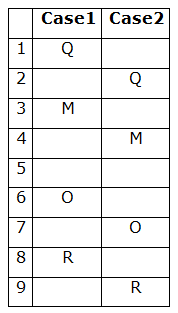
Again we have,
- The number of persons who stand before R is the same as the number of persons who stand after P.
- S stands two persons before T who stands in an odd number position.
From the above condition, there are three possibilities.
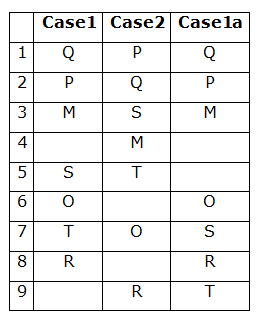
Again we have,
- N stands before U.
- N does not stand adjacent to M
From the above condition, case1 and case1a get eliminated. Case2 shows the final arrangement.
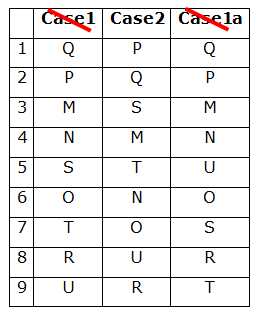
16) Answer: C
17) Answer: C
18) Answer: E
19) Answer: D
20) Answer: B
Direction (21-25): Study the following information carefully and answer the below questions
Eight persons- N, O, P, Q, R, S, T, and U are sitting on the square table such that four of them sit at the corner of the table and four of them sit at the middle of the table. They are facing the center. All the information is not necessarily in the same order.
R sits third to the left of N. Q sits neither adjacent to R nor N. Q does not sit corner of the table. O sits immediate right of Q. The number of persons sits between R and O is the same as the number of persons sits between R and T. S and N are immediate neighbours. U sits second to the left of P.
21) Who among the following person sits immediate right of P?
A.U
B.R
C.The one who sits second to the left of S
D.The one who sits immediate left of Q
E.O
22) Who among the following person sits opposite to N?
A.The one who sits immediate right of O
B.Q
C.The one who sits second to the left of T
D.S
E.P
23) How many persons are sitting between O and S when counted from the left of O?
A.Three
B.Two
C.One
D.More than three
E.None
24) Who among the following persons are not sitting at the corner of the table?
I) The one who sits immediate left of Q
II) The one who sits second to the right of R
III) The one who sits opposite to N
IV) P
A.Only II and IV
B.Only I and III
C.Only III and IV
D.Only I and IV
E.All I, II, III and IV
25) If all the persons are sitting alphabetical order from N in clockwise order, then how many persons are unchanged in their position? (excluding N)
A.More than three
B.None
C.Three
D.Two
E.One
Direction (26-30): Study the following information carefully and answer the questions given below.
Eight people P, Q, R, S, T, U, V, and W are sitting at a square table. All of them are facing the center of the table. Four persons sitting at the corners of the table and four persons sitting at the middle of the sides of the table.
T is facing W, who sits second to the right of S. Two persons sit between S and Q, who is not an immediate neighbor of T. P sits second to the left of R, neither of them sits at the corners of the table. R and T are not an immediate neighbours. At least two persons sit between P and V from both sides.
26) Who among the following persons sits immediate left of V?
A.The person who is facing P
B.U
C.The person who sits immediate left of W
D.Q
E.Both A & D
27) How many persons sit between S and V?
A.One
B.Two
C.Three
D.Four
E.None
28) If all the persons are arranged in alphabetical order starting from P in an anticlockwise direction, then how many persons remain in the same position including P?
A.One
B.Two
C.Three
D.Four
E.None
29) Four of the following five are alike in a certain way and thus form a group as per the given arrangement. Which of the following does not belong to that group?
A.The one who sits immediate left of U
B.W
C.The one who sits opposite to V
D.T
E.R
30) What is the position of P with respect to W?
A.Fifth to the left
B.Third to the left
C.Fourth to the right
D.Fifth to the right
E.Both B & D
Try Puzzle Questions For Online Mock Test
Answers :
Directions (21-25) :
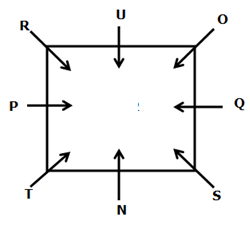
We have,
- R sits third to the left of N.
- Q sits neither adjacent to R nor N.
- Q does not sit corner of the table.
From the above condition, there are two possibilities.
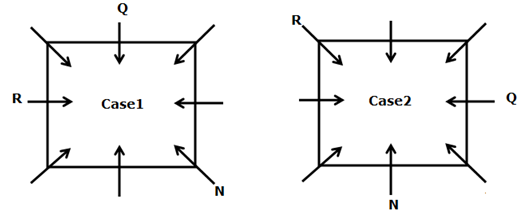
Again we have,
- O sits immediate right of Q.
- The number of persons sits between R and O is the same as the number of persons sits between R and T.
- S and N are immediate neighbors.
From the above condition, there are three possibilities.

Again we have,
- U sits second to the left of P.
From the above condition, case1 and case1a get eliminated. Case2 shows the final arrangement.

21) Answer: C
22) Answer: A
23) Answer: C
24) Answer: C
25) Answer: E
Directions (26-30) :
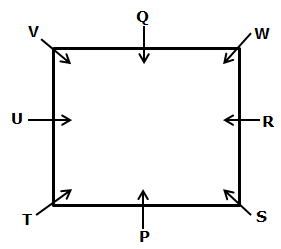
We have,
- T is facing W, who sits second to the right of S.
- Two persons sit between S and Q, who is not an immediate neighbor of T.
From the above condition, we have two possibilities.
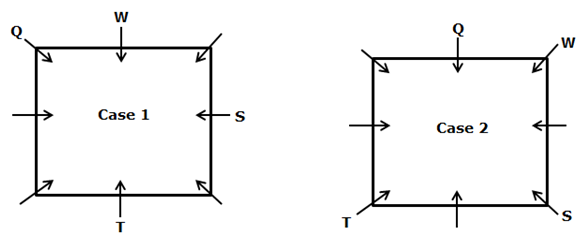
Again we have,
- P sits second to the left of R, neither of them sits at the corner of the table.
- R and T are not an immediate neighbours.
- At least two persons sit between P and V from both sides.
From the above condition case1 gets eliminated and case2 shows the final arrangement.
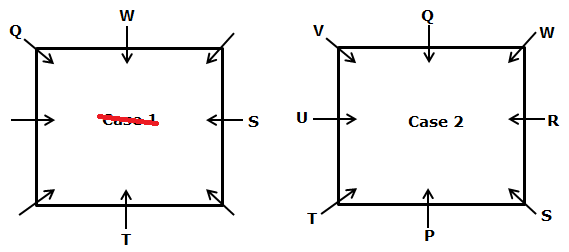
26) Answer: E
27) Answer: C
28) Answer: B
29) Answer: E
30) Answer: E
Direction (31-35): Study the following information carefully and answer the questions given below.
Eight persons viz. I, J, K, L, M, N, O and P are buying a product one after another, but not necessarily in the same order. Only one person buys the product at a time.
Only one person buys between O and K, who buys adjacent to N. N buys two persons before I, who doesn’t buy before O. Only three persons buy between I and M, who doesn’t buy at the last. L buys two persons before M but is not the first person to buy. More than three persons buy between J and P, who doesn’t buy before L.
31) Who among the following person buys the product at first?
A.The one who buys two persons before O
B.P
C.The one who buys four persons before L
D.M
E.None of these
32) If all the persons buy the product in alphabetical order from first, then how many persons remain unchanged in their position?
A.One
B.Two
C.Three
D.More than three
E.None
33) How many persons buy between L and K?
A.One
B.As many persons between I and M
C.More than three
D.As many persons between N and O
E.None
34) What is the position of P with respect to N?
A.Three persons before
B.Immediately after
C.Two persons after
D.Five persons before
E.None of these
35) The number of persons buying the product before M is the same as after ___.
A.N
B.P
C.K
D.I
E.None of these
Direction (36-40): Study the following information carefully and answer the questions given below.
Eight people P, Q, R, S, T, U, V, and W are going to the post office for posting their letters one after another in sequential order but not necessarily in the same order.
Three persons post their letters between T and W, neither of them at first nor at last. S posts three persons after T. Only one person posts between S and P, who doesn’t post after W. As many persons posts before P is one less than after P. Q posts before V but not at the first. U posts exactly between P and S.
36) Who among the following person posts the letter at first?
A.U
B.R
C.S
D.T
E.W
37) How many persons post the letters after V?
A.One
B.Two
C.Three
D.Four
E.No one
38) Four of the following five are alike in a certain way and thus form a group as per the given arrangement. Which of the following does not belong to that group?
A.PU
B.SW
C.TP
D.VW
E.RQ
39) If R is related to V and T is related to S, then who among the following person is related to U?
A.T
B.Q
C.P
D.W
E.No one
40) Which of the following statements is/are false?
A.Only one person post the letters after W
B.U post the letters immediately after P
C.Three persons post the letters before R
D.Both A and C
E.None of these
Try Puzzle Questions For Online Mock Test
Answers :
Directions (31-35) :

- Only one person buys between O and K, who buys adjacent to N.
- N buys two persons before I, who doesn’t buy before O.
- Only three persons buy between I and M, who doesn’t buy at the last.
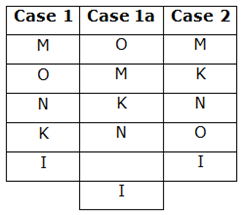
- L buys two persons before M but is not the first person to buy.
- More than three persons buy between J and P, who doesn’t buy before L.
Hence, cases 1 and 2 get eliminated case 1a shows the final arrangement.
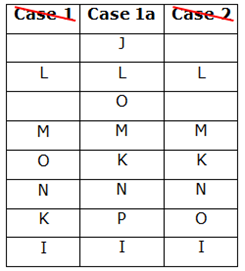
31) Answer: A
32) Answer: A
33) Answer: D
34) Answer: B
35) Answer: C
Directions (36-40) :
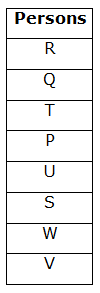
We have,
- Three persons post their letters between T and W, neither of them at first nor at last.
- S posts three persons after T.
- Only one person posts between S and P, who doesn’t post after W.
From the above condition, we have two possibilities.
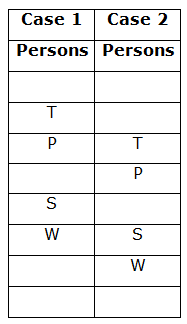
Again we have,
- As many persons posts before P is one less than after P.
- Q posts before V but not at the first.
- U posts exactly between P and S.
From the above condition, case1 gets eliminated and case2 shows the final arrangement.

36) Answer: B
37) Answer: E
38) Answer: D
39) Answer: C
40) Answer: C





